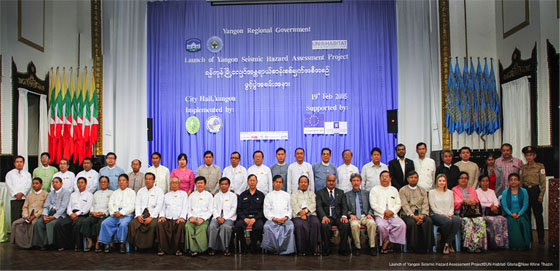Yangon, Myanmar, 20th February, 2015:
Seismic hazard assessment for Yangon City was launched by Yangon Regional Government, Yangon City Development Committee (YCDC) and UN-Habitat in collaboration with and Relief and Resettlement Department (RRD), Ministry of Social Welfare, Relief and Resettlement (MOSWRR) on 19th February 2015 at the Yangon City Hall. Yangon city the commercial capital of Myanmar with a population of 5 Million lies along the Sagaing fault and the city has been undergoing rapid transformation as part of the broader market oriented reform process of the Government. The assessment will be undertaken by Myanmar Geo-Sciences Society and Myanmar Earthquake Committee in collaboration with the City Development Committee, academic universities and the private sector.
The project is supported by the European Commission’s Humanitarian Aid and Civil Protection department (ECHO) as part of DIPECHO IX Action Plan for South East Asia in Myanmar, and by the Norwegian Ministry of Foreign Affairs. It is implemented by UN-Habitat as part of the Myanmar Consortium for Community Resilience (MCCR).

The launch meeting brought together over 100 participants from Regional Government, Yangon City Development Committee, universities, professional society, Myanmar Red Cross Society, members of Disaster Risk Reduction Working Group and the media. Dr. Myint Thein, Social Welfare Minister, Yangon Regional Government stressed the importance of both structural and non-structural mitigation measures to address disaster risk and importance of understanding the risks through sound assessment to guide the development process including awareness raising and promoting earthquake resistant buildings. The current efforts to undertake seismic hazard assessment for Yangon city, builds on the past work of earthquake risk assessment for Bago, Sagaing and Taungoo supported by the European Commission’s Humanitarian Aid and Civil Protection department (ECHO) through the Myanmar Consortium for Community Resilience (MCCR,) noted Mr. Nicolas Louis, Head of ECHO’s Yangon office.
Mr. Bijay Karmacharya, Country Programme Manager , UN-Habitat highlighted that Cities and urban centers in the past along the Sagaing fault experienced major earthquakes and those cities have undergone substantial changes over the years. In 1930, Magnitude 7.0 earthquake struck Bago region which caused extensive damage and killed around 500 people and in particular around 50 in Yangon city alone (then with a population of 0.4 million). The assessment process will also lead to building national capacities to undertake such assessment in other cities which are equally prone to earthquakes”, he highlighted in the speech.
Experts from Department of Meteorology and Hydrology, Myanmar Earthquake Committee and Myanmar Geosciences Society (MGS) presented the lessons learned from recent earthquakes and status of seismic hazard assessment in the country. Experts also discussed the framework also the partnership and collaboration for undertaking seismic hazard assessment for Yangon City.
About Myanmar Consortium for Community Resilience (MCCR):The Myanmar Consortium for Community Resilience (MCCR) is part of the DIPECHO IX Action Plan for South East Asia in Myanmar. MCCR is comprised of five INGOs and one UN Agency namely Action Aid, Plan International, Oxfam, Help Age International, Action Contre la Faim and UN-Habitat.







